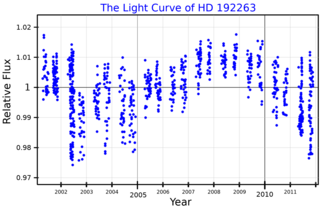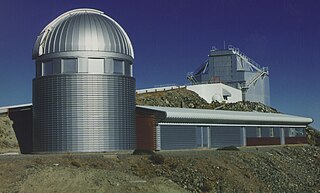Related Research Articles
HD 82943 is a yellow dwarf star approximately 89 light-years away in the constellation of Hydra. Two extrasolar planets have been confirmed to be orbiting it, and it is thought that the system had more giant planets that were "swallowed" by the parent star. HD 82943 is estimated at 1.15 times the mass of the Sun.
HD 169830 is a star in the southern constellation of Sagittarius. It has a yellow-white hue and is dimly visible to the naked eye with an apparent visual magnitude of +5.90. The star is located at a distance of 120 light years from the Sun based on parallax. It is drifting closer with a radial velocity of −17.3 km/s, and is predicted to come as close as 20.7 ly (6.4 pc) in 2.08 million years. HD 169830 is known to be orbited by two large Jupiter-like exoplanets.
HD 83443 is an orange dwarf star approximately 134 light-years away in the constellation of Vela. As of 2000, at least one extrasolar planet has been confirmed to be orbiting the star. The star HD 83443 is named Kalausi. The name was selected in the NameExoWorlds campaign by Kenya, during the 100th anniversary of the IAU. The word Kalausi means a very strong whirling column of wind in the Dholuo language.
HD 216770 is an 8th-magnitude star located approximately 124 light-years away in the constellation of Piscis Austrinus. It is an orange dwarf, and is somewhat dimmer and cooler than the Sun.

HD 192263 is an 8th magnitude star about 64 light years away in the constellation of Aquila. The spectral type of the star is K2V, meaning that it is an orange dwarf, a type of star somewhat cooler and less luminous than the Sun. It is not visible to the unaided eye, but with good binoculars or small telescope it should be easy to spot.
HD 28185 is a yellow dwarf star similar to the Sun located 128 light-years away from Earth in the constellation Eridanus. The designation HD 28185 refers to its entry in the Henry Draper catalogue. The star is known to possess one long-period extrasolar planet.

HD 28185 b is an extrasolar planet 128 light-years away from Earth in the constellation of Eridanus. The planet was discovered orbiting the Sun-like star HD 28185 in April 2001 as a part of the CORALIE survey for southern extrasolar planets, and its existence was independently confirmed by the Magellan Planet Search Survey in 2008. HD 28185 b orbits its sun in a circular orbit that is at the inner edge of its star's habitable zone.
HD 82943 c is an extrasolar planet approximately 89 light-years away in the constellation of Hydra. The planet was announced in 2001 to be orbiting the yellow dwarf star HD 82943. The planet is the innermost planet of two.
HD 196050 is a triple star system located in the southern constellation of Pavo. This system has an apparent magnitude of 7.50 and the absolute magnitude is 4.01. It is located at a distance of 165 light-years from the Sun based on parallax, and is drifting further away with a radial velocity of +61 km/s. It is also called by the Hipparcos designation HIP 101806.
HD 213240 is a possible binary star system in the constellation Grus. It has an apparent visual magnitude of 6.81, which lies below the limit of visibility for normal human sight. The system is located at a distance of 133.5 light years from the Sun based on parallax. The primary has an absolute magnitude of 3.77.
HD 216770 b is an extrasolar planet orbiting the star HD 216770. It has a mass about two thirds that of Jupiter, largest planet in the Solar System. But unlike the gas giants in the Solar System, it orbits in a very eccentric orbit around the star. The mean distance from the star is slightly larger than Mercury's, and it completes one orbit around the star in every 118 days.
HD 111232 b is an extrasolar planet that orbits at almost 2 AU with a minimum mass of 6.8 times that of Jupiter. This planet was discovered in the La Silla Observatory by Michel Mayor using the CORALIE spectrograph on 30 June 2003, along with six other planets, including HD 41004 Ab, HD 65216 b, HD 169830 c, HD 216770 b, HD 10647 b, and HD 142415 b.
HD 169830 b is an extrasolar planet three times the mass of Jupiter. Due to its high mass, it is most likely a gas giant planet, akin to Jupiter and Saturn in the Solar System. This planet at 0.8 AU is slightly farther out than Venus is in the Solar System, orbiting around its star every 262 days.
HD 82943 b is an extrasolar planet approximately 89 light-years away in the constellation of Hydra. The planet was announced in 2000 by the Geneva Extrasolar Planet Search Team. The planet is the outermost planet of two.
HD 75289 b is an extrasolar planet orbiting the star HD 75289 in Vela constellation. It has a minimum mass half that of Jupiter, and it orbits in a very short orbit completing one circular revolution around the star in three and a half days. By studying the starlight scientists have concluded that the planet must have an albedo less than 0.12, rather low for a gas giant. Otherwise its reflected light would have been detected.
HD 65216 b is an extrasolar planet located approximately 115 light-years away in the constellation of Carina, orbiting the star HD 65216. This planet was discovered by the Geneva Extrasolar Planet Search Team in 2003. Like most planet candidates so far, it was detected with the radial velocity method.
HD 212301 b is an extrasolar planet located approximately 172 light-years away in the constellation of Octans, orbiting the star HD 212301. It has an orbital period of 2.25 Earth days. The orbital distance is 0.0341 astronomical units or 5.10 gigameters.
HD 192263 b is a gas giant planet with a mass about three quarters that of Jupiter mass. It orbits the star in a circular orbit completing one revolution in 24 days or so. It was discovered in 2000 by the Geneva Extrasolar Planet Search team. The planet was independently detected by the California and Carnegie Planet Search team.

Leonhard Euler Telescope, or the Swiss EULER Telescope, is a national, fully automatic 1.2-metre (47 in) reflecting telescope, built and operated by the Geneva Observatory. It is located at an altitude of 2,375 m (7,792 ft) at ESO's La Silla Observatory site in the Chilean Norte Chico region, about 460 kilometers north of Santiago de Chile. The telescope, which saw its first light on 12 April 1998, is named after Swiss mathematician Leonhard Paul Euler.
HD 204313 is a star with two and possibly three exoplanetary companions in the southern constellation of Capricornus. With an apparent magnitude of 7.99, it is an eighth magnitude star that is too faint to be readily visible to the naked eye. The star is located at a distance of 157 light years from the Sun based on parallax measurements, but it is drifting closer with a radial velocity of −10 km/s.
References
- 1 2 Santos, N. C.; et al. (2001). "The CORALIE survey for southern extra-solar planets VI. New long period giant planets around HD 28185 and HD 213240". Astronomy and Astrophysics. 379 (3): 999–1004. arXiv: astro-ph/0106255 . Bibcode:2001A&A...379..999S. doi:10.1051/0004-6361:20011366. S2CID 59061741.
- 1 2 3 Xiao, Guang-Yao; Liu, Yu-Juan; et al. (May 2023). "The Masses of a Sample of Radial-Velocity Exoplanets with Astrometric Measurements". Research in Astronomy and Astrophysics . 23 (5): 055022. arXiv: 2303.12409 . Bibcode:2023RAA....23e5022X. doi:10.1088/1674-4527/accb7e.
- ↑ "HD 213240". Exoplanet Exploration. NASA. Retrieved 3 October 2020.
- ↑ "CORALIE". European Southern Observatory. Retrieved 3 October 2020.